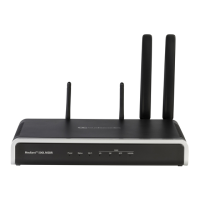User's Manual 67. Configuration Parameters Reference
Version 6.8 961 Mediant 500L MSBR
Parameter Description
EMS: Send ISDN Transfer On
Connect
CLI: isdn-trsfr-on-conn
[SendISDNTransferOnConne
ct]
connect an incoming and outgoing call. This parameter determines
if the outgoing call (from the device to the PBX) must be connected
before the transfer is initiated.
[0] Alert = (Default) Enables ISDN Transfer if the outgoing call is
in Alerting or Connect state.
[1] Connect = Enables ISDN Transfer only if the outgoing call is
in Connect state.
Note: For RLT ISDN transfer (TrunkTransferMode = 2 and
ProtocolType = 14 DMS-100), this parameter must be set to 1.
[ISDNTransferCompleteTime
out]
Defines the timeout (in seconds) for determining ISDN call transfer
(ECT, RLT, or TBCT) failure. If the device does not receive any
response to an ISDN transfer attempt within this user-defined time,
the device identifies this as an ISDN transfer failure and
subsequently performs a hairpin TDM connection or sends a SIP
NOTIFY message with a SIP 603 response (depending whether
hairpin is enabled or disabled, using the parameter
DisableFallbackTransferToTDM).
The valid range is 1 to 10. The default is 4.
Web/EMS: Enable Network
ISDN Transfer
CLI: network-isdn-xfer
[EnableNetworkISDNTransfer
]
Determines whether the device allows interworking of network-side
received ECT/TBCT Facility messages (NI-2 TBCT - Two B-
channel Transfer and ETSI ECT - Explicit Call Transfer) to SIP
REFER.
[0] Disable = Rejects ISDN transfer requests.
[1] Enable = (Default) The device sends a SIP REFER message
to the remote call party if ECT/TBCT Facility messages are
received from the ISDN side (e.g., from a PBX).
[DisableFallbackTransferToT
DM]
Enables "hairpin" TDM transfer upon ISDN (ECT, RLT, or TBCT)
call transfer failure. When this feature is enabled and an ISDN call
transfer failure occurs, the device sends a SIP NOTIFY message
with a SIP 603 Decline response.
[0] = (Default) The device performs a hairpin TDM transfer upon
ISDN call transfer.
= Hairpin TDM transfer is disabled.
Web: Enable QSIG Transfer
Update
CLI: qsig-xfer-update
[EnableQSIGTransferUpdate]
Determines whether the device interworks QSIG Facility messages
with CallTranferComplete or CallTransferUpdate invoke application
protocol data units (APDU) to SIP UPDATE messages with P-
Asserted-Identity and optional Privacy headers. This feature is
supported for IP-to-Tel and Tel-to-IP calls.
[0] Disable = (Default) Ignores QSIG Facility messages with
CallTranferComplete or CallTransferUpdate invokes.
[1] Enable
For example, assume A and C are PBX call parties and B is the SIP
IP phone:
1 A calls B; B answers the call.
2 A places B on hold and calls C; C answers the call.
3 A performs a call transfer (the transfer is done internally by the
PBX); B and C are connected to one another.
In the above example, the PBX updates B that it is now talking with
C. The PBX updates this by sending a QSIG Facility message with
CallTranferComplete invoke APDU. The device interworks this
message to a SIP UPDATE message containing a P-Asserted-
Identity header with the number and name derived from the QSIG

